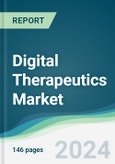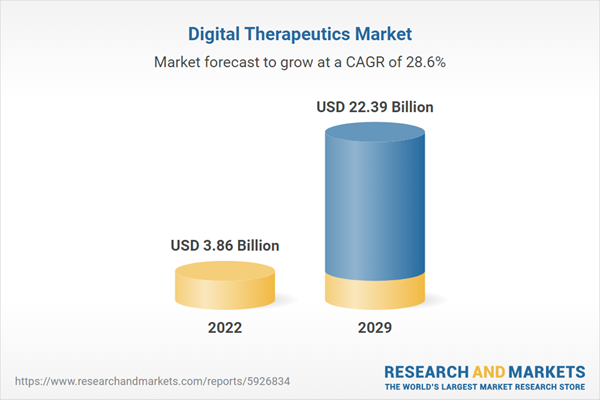The intersection of technology and healthcare is witnessing a rapid emergence known as digital therapeutics, or DTx. These innovative treatments leverage digital resources such as wearables, software, and mobile applications to provide evidence-based therapeutic interventions for preventing, managing, or treating medical disorders. In some cases, DTx solutions can either supplement or entirely replace conventional pharmacological treatments, offering personalized, scalable, and cost-effective options.
The digital therapeutics market growth is propelled by various factors highlighting the potential of these software-based solutions to enhance healthcare delivery and improve patient outcomes. Chronic diseases like diabetes, heart disease, and obesity pose significant global challenges, straining traditional healthcare systems with escalating costs and limited resources. DTx solutions step in with personalized and scalable interventions that complement traditional treatment plans, empowering patients to better manage their conditions.
The healthcare landscape is shifting towards a preventive approach, and DTx solutions are pivotal in early disease detection, risk assessment, and promoting healthy lifestyle habits. Through continuous monitoring of health data via mobile apps and wearables, early intervention becomes possible, potentially preventing the onset of chronic diseases.
Compared to traditional treatment methods, DTx solutions offer a cost-effective approach to managing chronic diseases, potentially reducing hospital admissions, medication costs, and overall healthcare expenditure in the long term.
The DTx market is propelled by ongoing technological advancements, particularly in areas like artificial intelligence (AI), big data analytics, and mobile health technology. These advancements lead to the development of more sophisticated and effective DTx solutions.
In summary, the digital therapeutics market is driven by a compelling combination of factors. As the burden of chronic diseases grows, healthcare systems seek cost-effective solutions while technology continues to evolve. DTx solutions are poised to revolutionize healthcare delivery, empowering patients to take control of their well-being.
Market Drivers:
Growing demand for smart medical devices for better health diagnosis & tracking is accelerating the market expansion.
The digital therapeutics market is driven by several important factors that work together to promote its expansion and uptake. For instance, the growing prevalence of chronic diseases emphasizes the need for practical and affordable approaches to illness management and treatment.Simultaneously, wearables and smartphone applications that are part of the continuous technical breakthroughs in digital health technologies expand the capabilities and reach of digital medicines, increasing their appeal to patients and healthcare professionals.
Furthermore, Germany's healthcare spending by sources climbed from 4,74,134 million euros in 2021 to 4,98,126 million euros in 2022, according to the Statistisches Bundesamt. In addition, according to the Federal Statistical Office (Destatis), health spending in 2021 was 33.1 billion euros more than in 2020, the year of the pandemic.
In 2021, 13.2% of GDP was allocated to health-related expenses, 0.2 percentage points greater than in 2020. This growth in healthcare spending supports digital therapies' development, use, and reimbursement as workable components of contemporary healthcare systems.
Growing use of Internet and mobile
The increasing prevalence of internet and mobile technology plays a pivotal role in propelling the DTx market for several reasons. Firstly, the widespread availability of Internet and mobile devices significantly enhances the accessibility of DTx solutions to a broader population. Patients can conveniently access these programs from any location with an internet connection, thereby eliminating geographical barriers and enhancing healthcare access, particularly in remote areas.Statistics indicate that a substantial portion of the global population utilizes mobile and internet technologies, with 78% and 67% of individuals, respectively, engaging with these platforms, according to ITU. This widespread adoption further underscores the potential reach and impact of DTx solutions.
Moreover, the interactive nature of the internet and mobile technology fosters increased user engagement with DTx programs. Features such as gamification, personalized feedback, and real-time data visualization contribute to making therapy sessions more immersive and motivating for patients. Consequently, this heightened engagement leads to improved adherence to treatment protocols and ultimately results in better therapeutic outcomes.
Digital therapeutics market by type into devices, software & services
In terms of categorization, the digital therapeutics market can be divided into three main types: devices, software, and services. Software-based DTx solutions offer a remarkable degree of adaptability. They can be tailored to address a diverse array of medical conditions and are easily scalable to reach a large user base.Wearable devices represent a significant aspect of the devices category. These gadgets are capable of gathering real-time physiological data and facilitating continuous monitoring of vital signs, activity levels, and sleep patterns. Such data proves invaluable for effectively managing chronic illnesses and fostering overall well-being.
Within the services segment, the development of compelling, evidence-based educational content for DTx programs is paramount. This involves customizing content to cater to specific medical conditions and target demographics.
Additionally, providing ongoing support and guidance to patients utilizing DTx solutions can significantly enhance user engagement and improve treatment outcomes.
The market share Asia Pacific region is projected to hold a significant share
Technology-driven healthcare solutions are becoming more widely accepted and accessible as a result of the expansion of digital health. This expansion fuels market demand increasing the pool of possible consumers for digital treatments. Further propelling market expansion are regulatory procedures and reimbursement schemes for digital therapeutics, which are made easier by increased knowledge and acceptance of digital health instruments.The purpose of the Digital Health Incentive Scheme (DHIS) is to incentivize participants in the healthcare ecosystem. According to the National Health Authority of India, June had the highest registration rate as of June 30, 2023, with 684 new businesses registering throughout the month. In total, 1056 entities (1032 health facilities and 24 digital solution companies) had been registered as of June 30, 2023.
Forty facilities and four digital solution companies (DSCs) qualified for claims in April 2023. The claims that were made in January, February, and March have already been paid out. Plans call for the implementation of an automated system that handles the whole claims procedure, and steps have already been taken in that regard. The following DSCs were eligible to receive incentives in April 2023:
Bajaj Finserv Health - 3,175, C-DAC e-Sushrut AIIMS - 6,33,795, Orbi Health Private Limited - 39,010, and Paytm - 13,955. (Source: National Health Authority)
Comprehensively, a convergence of factors influencing the future of healthcare is driving a dynamic and growing landscape in the digital therapeutics sector. The connection between technology and pharmaceuticals has unmatched potential for proactive and individualized healthcare treatments.
Furthermore, the continuous progress in digital health technology, in conjunction with the necessity to tackle the increasing prevalence of chronic illnesses, highlights the revolutionary possibilities of digital therapies in enhancing patient outcomes and healthcare provision.
Market Developments:
- February 2024 - The debut of its unified technology, site services, and CRO services package for DTx and digital health trials was announced by Lindus Health, an "anti-CRO" that runs clinical trials for life science pioneers at a rate that is dramatically quicker and more dependable.
- October 2023 - A new Health Economics and Outcomes Research (HEOR) Practice was launched by Curavit Clinical Research, a virtual contract research organization (VCRO) that specializes in decentralized clinical trials (DCTs) for digital therapies.
- October 2023 - A leader in the development of prescription digital therapeutics (PDTs) for the treatment of cardiometabolic diseases, Better Therapeutics, Inc., announced the commercial launch of AspyreRx, the first cognitive behavioural therapy (CBT) app authorized by the US Food and Drug Administration (FDA) as a Class II device for the treatment of adults with type 2 diabetes (T2D).
Key Players:
- Omada Health Inc. - Omada Health Inc.'s digital platforms combine clinical protocols and behaviour science to provide long-lasting health benefits.
- Welldoc Inc. - Welldoc Inc., through its digital platforms, aims to navigate the ever-evolving digital health landscape by answering the complexity of chronic conditions via its technology.
Market Segmentation:
By Type
- Devices
- Software & Services
By Application
- Diabetes
- Obesity
- CVD
- Respiratory Diseases
- Smoking Cessation
- CNS Diseases
- Other
By End-user
- Patients
- Providers
- Payers
- Employers
- Others
By Geography
- North America
- USA
- Canada
- Mexico
- South America
- Brazil
- Argentina
- Others
- Europe
- Germany
- France
- UK
- Spain
- Others
- Middle East and Africa
- Saudi Arabia
- UAE
- Israel
- Others
- Asia Pacific
- China
- Japan
- India
- South Korea
- Indonesia
- Thailand
- Others
Table of Contents
Companies Mentioned
- Omada Health, Inc.
- Welldoc, Inc.
- 2Morrow, Inc
- Livongo Health, Inc. (Teladoc Health, Inc.)
- Propeller Health (ResMed)
- Fitbit LLC
- CANARY HEALTH
- Noom, Inc.
- Akili Interactive Labs, Inc.
Table Information
| Report Attribute | Details |
|---|---|
| No. of Pages | 146 |
| Published | March 2024 |
| Forecast Period | 2022 - 2029 |
| Estimated Market Value ( USD | $ 3.86 Billion |
| Forecasted Market Value ( USD | $ 22.39 Billion |
| Compound Annual Growth Rate | 28.5% |
| Regions Covered | Global |
| No. of Companies Mentioned | 9 |









